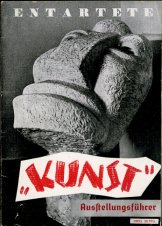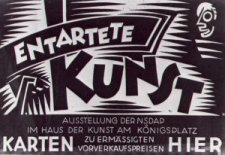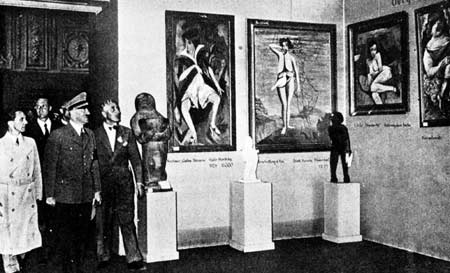
To
order Hitler Sites ($55)
click here
Köpenickerstraße 24, Kreuzberg.
Victoria-Speicher I (destroyed warehouse, memorial plaque).
|
|
From 1937 to 1939, the Nazis used a building on this site to store “degenerate
art.” The Aktion Entartete Kunst had confiscated this art: 16,558 expressionist,
abstract, and socially critical works, as well as the works of Jewish artists. A
plaque commemorates the closing of the warehouse on March 20, 1939. The building
itself was destroyed during the war.
In summer 1937, Joseph Goebbels’ degenerate art commission canvassed Germany,
searching public and private collections. Propaganda office officials seized the
works of Otto Dix, Oskar Kokoschka, Erich Nolde, Ernst Ludwig Kirchner, Max
Pechstein, and Käthe Kollwitz, among others. Especially hard hit was the modern
art division of the Berlin National Gallery, which lost 136 paintings, 28
sculptures, and 324 drawings.
 Goebbels first visited the warehouse on November 4, 1937. The painter Adolf
Ziegler, President of the Reich Chamber of Artists, and architect Albert Speer
accompanied him. In his diary, Goebbels wrote, “Very few borderline cases. The
rest is such dreck that a three hour visit makes one sick.”
Goebbels first visited the warehouse on November 4, 1937. The painter Adolf
Ziegler, President of the Reich Chamber of Artists, and architect Albert Speer
accompanied him. In his diary, Goebbels wrote, “Very few borderline cases. The
rest is such dreck that a three hour visit makes one sick.”
In order to convince Hitler to legalize the confiscations that had already taken
place, Goebbels gave him a tour of the warehouse on January 13, 1938. “No
picture was acceptable,” wrote Goebbels in his diary. “Führer also wants no
compensation paid to the owners. We will exchange a few of the works outside of
Germany for real masterpieces.”
On May 31, 1938, the seizure without compensation of degenerate art was
legalized ex post facto. At the same time, avant-garde artists living in Germany
were forbidden to paint. To obtain foreign currency, four German art dealers
were appointed to find foreign customers for some of the degenerate art. Most of
the remainder was sent to a gallery in Lucerne for international sale. Before
shipment, the works were displayed in the rooms of a castle, Schloß
Niederschönhausen.
Franz Hofmann, the director of fine art and art critic of the Völkischer
Beobachter, recommended that “the worthless, unsalable remainder be dumped in a
trash heap and symbolically burned,” Goebbels wrote. “I should also deliver a
peppery eulogy.”
 But Goebbels reserved many works for an “instructional” and propaganda exhibit,
“Degenerate Art,” which traveled to large German and Austrian cities. From
February 26th to May 8th, 1938, the works were on display in Berlin, at the
“Haus der Kunst,” Königsplatz 4.
But Goebbels reserved many works for an “instructional” and propaganda exhibit,
“Degenerate Art,” which traveled to large German and Austrian cities. From
February 26th to May 8th, 1938, the works were on display in Berlin, at the
“Haus der Kunst,” Königsplatz 4.
The exhibit catalogue is a rarity today. It disparaged the anti-war pictures of
Otto Dix as “defense-sabotage.” A painting by a schizophrenic in a mental
hospital “looks more human than any concoction of Paul Klee.” A painting by Kurt
Schwitters was “the height of stupidity or impudence--or both.” But one German
commented, “the Nazis, in spite of themselves, gave us the chance to become
acquainted with the crème of modern art, all in one place.”


